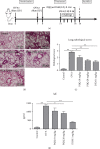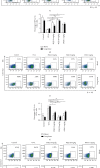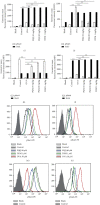Pyrroloquinoline Quinone Administration Alleviates Allergic Airway Inflammation in Mice by Regulating the JAK-STAT Signaling Pathway
- PMID: 36345503
- PMCID: PMC9637035
- DOI: 10.1155/2022/1267841
Pyrroloquinoline Quinone Administration Alleviates Allergic Airway Inflammation in Mice by Regulating the JAK-STAT Signaling Pathway
Abstract
The current asthma therapies are inadequate for many patients with severe asthma. Pyrroloquinoline quinone (PQQ) is a naturally-occurring redox cofactor and nutrient that can exert a multitude of physiological effects, including anti-inflammatory and antioxidative effects. We sought to explore the effects of PQQ on allergic airway inflammation and reveal the underlying mechanisms. In vitro, the effects of PQQ on the secretion of epithelial-derived cytokines by house dust mite- (HDM-) incubated 16-HBE cells and on the differentiation potential of CD4+ T cells were investigated. In vivo, PQQ was administered to mice with ovalbumin- (OVA-) induced asthma, and lung pathology and inflammatory cell infiltration were assessed. The changes in T cell subsets and signal transducers and activators of transcription (STATs) were evaluated by flow cytometry. Pretreatment with PQQ significantly decreased HDM-stimulated thymic stromal lymphopoietin (TSLP) production in a dose-dependent manner in 16-HBE cells and inhibited Th2 cell differentiation in vitro. Treatment with PQQ significantly reduced bronchoalveolar lavage fluid (BALF) inflammatory cell counts in the OVA-induced mouse model. PQQ administration also changed the secretion of IFN-γ and IL-4 as well as the percentages of Th1, Th2, Th17, and Treg cells in the peripheral blood and lung tissues, along with inhibition the phosphorylation of STAT1, STAT3, and STAT6 while promoting that of STAT4 in allergic airway inflammation model mice. PQQ can alleviate allergic airway inflammation in mice by improving the immune microenvironment and regulating the JAK-STAT signaling pathway. Our findings suggest that PQQ has great potential as a novel therapeutic agent for inflammatory diseases, including asthma.
Copyright © 2022 Zhihui Min et al.
Conflict of interest statement
The authors declare that they have no competing interests.
Figures






Similar articles
-
Bupleurum chinense extract ameliorates an OVA-induced murine allergic asthma through the reduction of the Th2 and Th17 cytokines production by inactivation of NFκB pathway.Biomed Pharmacother. 2017 Jul;91:1085-1095. doi: 10.1016/j.biopha.2017.04.133. Epub 2017 May 16. Biomed Pharmacother. 2017. PMID: 28531919
-
Inula japonica Thunb. and its active compounds ameliorate airway inflammation by suppressing JAK-STAT signaling.Biomed Pharmacother. 2025 Feb;183:117852. doi: 10.1016/j.biopha.2025.117852. Epub 2025 Jan 23. Biomed Pharmacother. 2025. PMID: 39854818
-
Progesterone modulates the immune microenvironment to suppress ovalbumin-induced airway inflammation by inhibiting NETosis.Sci Rep. 2024 Jul 26;14(1):17241. doi: 10.1038/s41598-024-66439-6. Sci Rep. 2024. PMID: 39060348 Free PMC article.
-
Current study on Pyrroloquinoline quinone (PQQ) therapeutic role in neurodegenerative diseases.Mol Biol Rep. 2025 Apr 15;52(1):397. doi: 10.1007/s11033-025-10491-6. Mol Biol Rep. 2025. PMID: 40234255 Review.
-
Janus kinase/signal transducers and activator of transcription (JAK/STAT) and its role in Lung inflammatory disease.Chem Biol Interact. 2023 Feb 1;371:110334. doi: 10.1016/j.cbi.2023.110334. Epub 2023 Jan 5. Chem Biol Interact. 2023. PMID: 36610610 Review.
Cited by
-
Pyrroloquinoline Quinone (PQQ): Its impact on human health and potential benefits: PQQ: Human health impacts and benefits.Curr Res Food Sci. 2024 Oct 22;9:100889. doi: 10.1016/j.crfs.2024.100889. eCollection 2024. Curr Res Food Sci. 2024. PMID: 39513102 Free PMC article. Review.
-
Pyrroloquinoline Quinone Reprograms the Single-Cell Landscape of Immune Aging in Hematopoietic Immune System.Aging Cell. 2025 Jul;24(7):e70050. doi: 10.1111/acel.70050. Epub 2025 Apr 7. Aging Cell. 2025. PMID: 40192736 Free PMC article.
-
Knockdown of KIF23 alleviates the progression of asthma by inhibiting pyroptosis.BMJ Open Respir Res. 2024 Apr 2;11(1):e002089. doi: 10.1136/bmjresp-2023-002089. BMJ Open Respir Res. 2024. PMID: 38569671 Free PMC article.
-
Pre-conditioning with PQQ during pregnancy alleviates LPS-induced placental damage and improves the fetal survival and growth in mice.Front Endocrinol (Lausanne). 2025 Jul 10;16:1617026. doi: 10.3389/fendo.2025.1617026. eCollection 2025. Front Endocrinol (Lausanne). 2025. PMID: 40708725 Free PMC article.
-
SPIN: sex-specific and pathway-based interpretable neural network for sexual dimorphism analysis.Brief Bioinform. 2024 May 23;25(4):bbae239. doi: 10.1093/bib/bbae239. Brief Bioinform. 2024. PMID: 38807262 Free PMC article.
References
-
- Noji N., Nakamura T., Kitahata N., et al. Simple and sensitive method for pyrroloquinoline quinone (PQQ) analysis in various foods using liquid chromatography/electrospray-ionization tandem mass spectrometry. Journal of Agricultural and Food Chemistry . 2007;55(18):7258–7263. doi: 10.1021/jf070483r. - DOI - PubMed
MeSH terms
Substances
LinkOut - more resources
Full Text Sources
Medical
Research Materials
Miscellaneous

